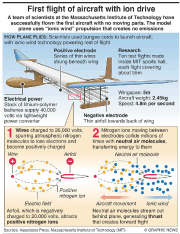E-Archive
Off the Beaten Track
in Vol. 23 - May Issue - Year 2022
Ionic Wind

It looked like a group of grown-up kids playing with their toy glider on a boring autumn day. They had set up a launch ramp with bungee ropes in their school’s gym. While some of them fiddled with wires on the wings’ leading and aft edges, others set up a video camera to record the event.
*****
The principle of ionic wind propulsion was theorized in the 18th century. In 1709 Francis Hauksbee, a member of the Royal Society and Isaac Newton’s lab assistant, published a book titled Physico-Mechanical Experiments on Various Subjects, in which he described the “electric wind” created by the movement of charged particles.
In the 1920s an American researcher named Thomas Townsend Brown attempted to make a connection between strong electric fields and gravity, mistakenly believing that he had discovered a type of antigravity force. He did not realize that what he had found was none other than the “electric wind” or “ionic wind” observed by Hauksbee over two centuries earlier. This phenomenon is called electroaerodynamics (EAD). Researchers realized that EAD could be used to create a flow of air through electrical energy, thus providing thrust to propel an aircraft without any moving parts, but the technology and the materials available were not advanced enough to develop a useful prototype.
In 1959 American aircraft designer Major Alexander Prokofieff de Seversky filed a patent for an “ionocraft”. He built a model VTOL (Vertical Takeoff and Landing) aircraft capable of lateral manoeuver by varying the voltages applied in different areas. The University of Florida built a saucer-shaped EAD aircraft model in 2008. The problem with these early models was that they could not carry the heavy power source necessary to generate sufficient thrust. They relied on batteries that fed electricity to the aircraft through long, thin flexible cables from the ground. In 2014 Ethan Krauss patented the first ion-propelled VTOL to take off and fly using its own onboard power supply.
Four years later, aerospace engineer Steve Barrett and his team at the Massachusetts Institute of Technology designed a fixed-wing aircraft capable of self-propelled flight with no moving parts. Their prototype looked like a glider, with a five-meter wingspan and weighing only 2.45 kg. Its propulsion system consisted of an array of thin wires stretched horizontally along and beneath the leading edge of the plane’s wings. Thicker wires shaped like airfoils were arranged in a similar fashion along the aft edge of the wings. These wires acted as electrodes. There was a power system to provide the 40,000 volts needed for thrust. A stack of small lithium-polymer batteries with a lightweight power converter was fitted into the bulb at the nose of the glider. This system provided a 20,000-volt positive charge to the forward wires and a 20,000-volt negative charge to the back wires. The positive charge caused atmospheric nitrogen molecules to lose electrons and become positive nitrogen ions that were forcibly attracted to the negatively charged back wires. Along the way these ions collided with millions of neutral air molecules and transferred kinetic energy. As they were ejected from the back of the wings, these air molecules generated a neutral wind, creating an equal and opposite force that caused the aircraft to move forward.
On that autumn day in 2018, Barrett’s team made history by flying a fixed-wing aircraft with no propellers, no jet engines, no moving parts and propelled only by ionic wind. Once the plane had been catapult-launched with the elastic band, the EAD system sustained the aircraft in level flight for the entire fifty-five-meter length of the sports hall at a speed of about 4.8 meters per second. They made ten test flights with their “MIT EAD Airframe Version 2” with the same results. A video of this historic flight can be viewed on the internet. Although it’s too early to say whether an ion-powered aircraft will carry passengers in the future, Barrett’s team was pleased to point out that their first test flight lasted exactly as long as the Wright brothers’ first flight: twelve seconds.
By Giovanni Gregorat, Contributing
Editor MFN



























